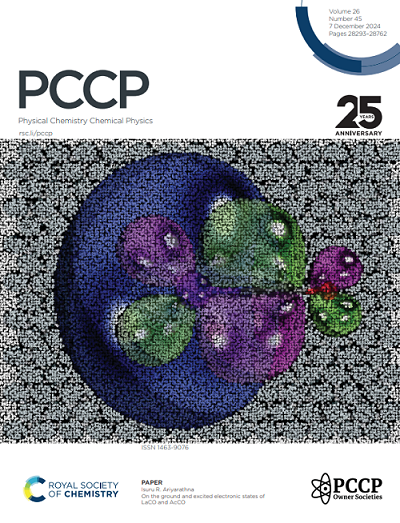Hybrid moiré excitons in strained heterobilayer of transition metal dichalcogenides
IF 2.9
3区 化学
Q3 CHEMISTRY, PHYSICAL
引用次数: 0
Abstract
In this paper, we theoretically study the effects of twist and heterostrain on moiré excitons in the $MoSe_2/WSe_2$ heterobilayer. Using a continuum model, we analyze the band structures and wavefunction distributions of moiré excitons, photoluminescence spectra, and the hybridization between interlayer and intralayer moiré excitons. Our key findings reveal that, under the influence of twisting effect, moiré excitons flat bands emerge. Additionally, we observe that the bright states exhibit a linear and quadratic dependence on the twist angle. We predict the existence of a critical twist angle, $\theta_c \simeq 2^\circ$, which distinguishes between localized and delocalized regimes. In contrast, the three-fold rotational symmetry breaking induced by heterostrain leads to significant tunability of the exciton band structure and the distribution of bright states. Moreover, exploring the strain magnitude and direction may enhance the brightness of moiré exciton bright states, emphasizing the importance of strain orientation in excitonic optical modulator applications. Furthermore, the combined effects of twist and strain result in a high degree of tunability in the hybridization between interlayer and intralayer excitons. Interestingly, under specific strain magnitudes and directions, such as normal compressive strain, we observe the emergence of a topological moiré exciton Chern insulator, featuring the protected edge modes. Our predictions may pave the way for exploring novel topological exciton phenomena and moiré exciton-correlated physics. They are particularly intriguing for potential device applications in the excitonic quantum anomalous Hall effect (EQAHE) enabled by the combined effects of strain and twist.过渡金属二硫族化合物应变异质层中的杂化莫尔激子
本文从理论上研究了扭转和异应变对$MoSe_2/WSe_2$异质层中振动激子的影响。利用连续介质模型,分析了微波激子的能带结构和波函数分布、光致发光光谱以及层间和层内微波激子的杂化。我们的主要发现表明,在扭曲效应的影响下,出现了波纹激子的平带。此外,我们观察到,明亮状态表现出线性和二次依赖于扭转角。我们预测存在一个临界扭角$\theta_c \simeq 2^\circ$,它区分了局域和非局域状态。相反,由异应变引起的三重旋转对称破缺导致激子能带结构和亮态分布具有明显的可调性。此外,探索应变的大小和方向可以提高莫尔激子亮态的亮度,强调应变方向在激子光调制器应用中的重要性。此外,扭转和应变的联合作用导致层间和层内激子的杂交具有高度的可调性。有趣的是,在特定的应变大小和方向下,例如正常的压缩应变,我们观察到出现了具有保护边缘模式的拓扑moir激子Chern绝缘子。我们的预测可能为探索新的拓扑激子现象和moirir激子相关物理铺平道路。它们对于在由应变和扭转的联合效应实现的激子量子反常霍尔效应(EQAHE)中的潜在器件应用尤其有趣。
本文章由计算机程序翻译,如有差异,请以英文原文为准。
求助全文
约1分钟内获得全文
求助全文
来源期刊

Physical Chemistry Chemical Physics
化学-物理:原子、分子和化学物理
CiteScore
5.50
自引率
9.10%
发文量
2675
审稿时长
2.0 months
期刊介绍:
Physical Chemistry Chemical Physics (PCCP) is an international journal co-owned by 19 physical chemistry and physics societies from around the world. This journal publishes original, cutting-edge research in physical chemistry, chemical physics and biophysical chemistry. To be suitable for publication in PCCP, articles must include significant innovation and/or insight into physical chemistry; this is the most important criterion that reviewers and Editors will judge against when evaluating submissions.
The journal has a broad scope and welcomes contributions spanning experiment, theory, computation and data science. Topical coverage includes spectroscopy, dynamics, kinetics, statistical mechanics, thermodynamics, electrochemistry, catalysis, surface science, quantum mechanics, quantum computing and machine learning. Interdisciplinary research areas such as polymers and soft matter, materials, nanoscience, energy, surfaces/interfaces, and biophysical chemistry are welcomed if they demonstrate significant innovation and/or insight into physical chemistry. Joined experimental/theoretical studies are particularly appreciated when complementary and based on up-to-date approaches.
 求助内容:
求助内容: 应助结果提醒方式:
应助结果提醒方式:


